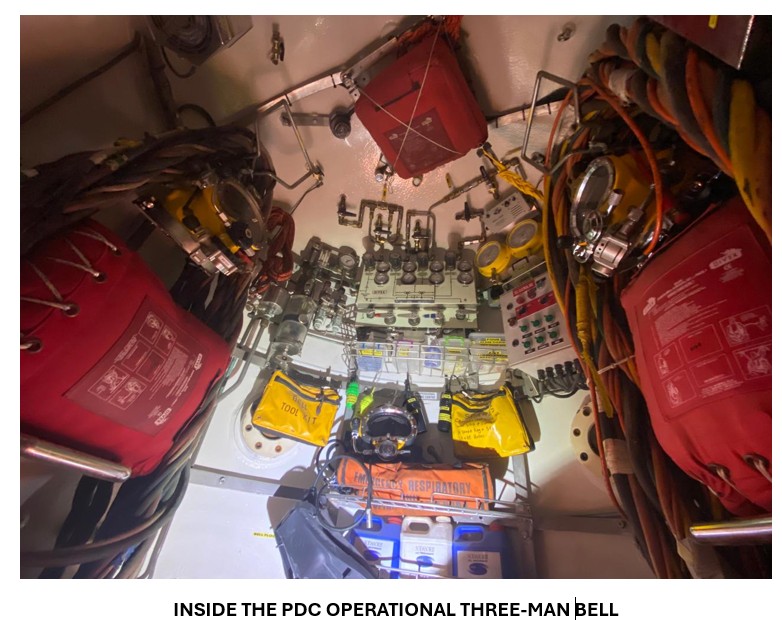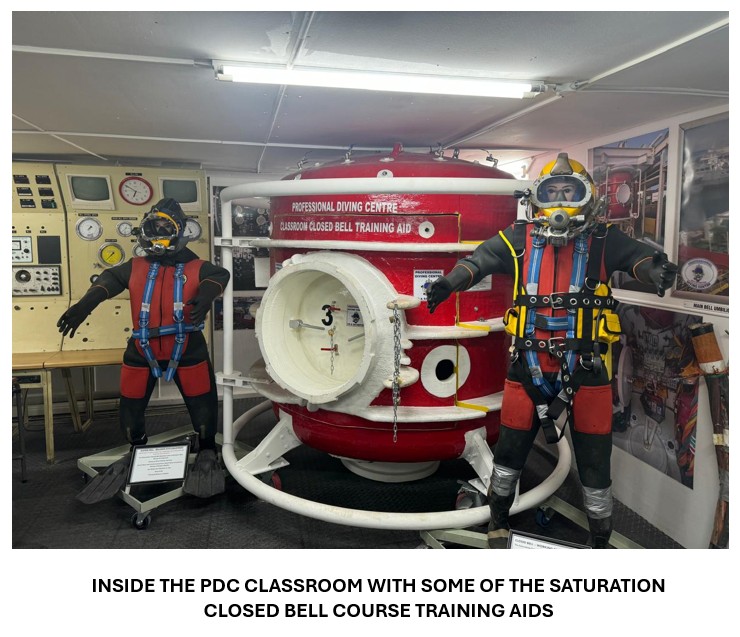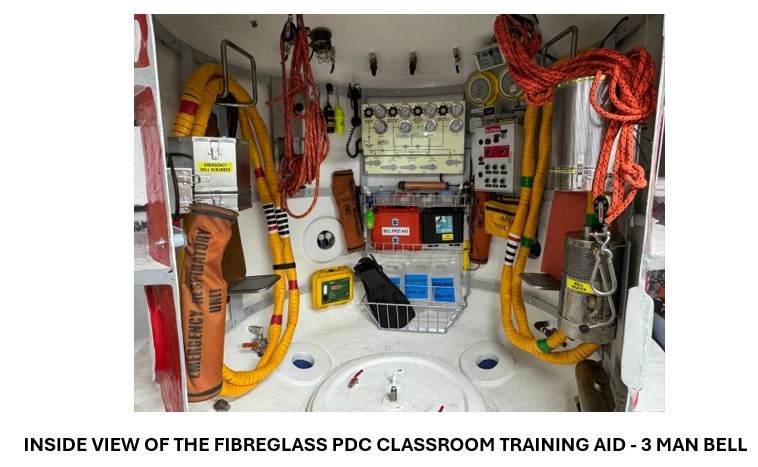Email Us At info@pdcclosedbell.comÂ
The Career Path to Saturation Closed Bell Diver Training
 The career of a saturation closed bell diver starts with the student attending a scuba and surface supply commercial air diver course preferably to 50 metres depth however a student diver can do 30 metres depth and return later to upgrade to 50 metres.   It is important that this training is recognised by IMCA.   Important to Note is that IMCA do not issue diver qualifications they only recognise certain countries 50 metre qualifications and the same goes for saturation closed bell courses.   Also very important is that you must attend comprehensive proper diver training and not short cut minimum cheap training.  Proper training costs money and it benefits your diving career.    There are hundreds of air divers looking for work and the mis-informed message by some out there is do the cheapest course you can for the shortest duration beware this will not benefit you at all and it will ensure you battle to keep a job as your knowledge and skill will be lacking and this type of minimal short cut cheap training will ensure you do not become competition to any diver looking for the next job.

The newly trained commercial diver would then spend at least 2 years working inshore in what is called the civils diving industry. In the civils diving industry, the work would include the following underwater tasks, Cleaning, Inspecting Ships, polishing propellers, welding anodes or temporary patches, lift eyes or fitting Coffer dams on ships so dry repairs can be carried out. This ship husbandry is conducted in the harbours or outside the harbours while the ship is moored or on anchor. Then there is are the salvage operations, Pipelines to and from the shore, Dam Wall maintenance, UW Mining of various minerals and Fish farm type diving in tanks or at sea there are also other surface supplied work tasks, these are a few named inshore diver work tasks. Gaining experience in Underwater CCTV and Photographs are most times included in the civils work such as shipping, pipelines etc, however this should be included in your diver training courses as well.
The next step in a diver’s career would be to plan to move towards the Offshore Air Diver Oil and Gas Industry work industry where the pay is better. The move into this Offshore Oil and Gas work requires you need to have held a Surface Supply Commercial diver qualification with the minimum trained depth of 50 metres, which includes skills such as, Dive Basket, Wet Bell and Decompression Chamber Operator Training including actual diving with real decompression including using Surface decompression techniques, this 50 metre training includes diving skills using power tools both Pnuemo and Hydraulics, HP water Jetting, CCTV, Photography with measurements, UW lift bags, UW Rigging, UW cutting called burning done with Oxygen a broco torch and Broco rods and then an introduction to underwater wet stick welding with the competence achieved to weld a 50 mm fillet bead as well as other skills. This 50-metre training qualification must be held for a minimum of 2 years before applying offshore.
If you did a 30-metre surface supply commercial diver course you would need to upgrade this to a 50-metre qualification and then have to wait 2 years as a 50-metre diver, hence a good reason to do the 50-metre training course from the start of your training or upgrade your 30-metre qualification as soon as possible after completing the 30-metre qualification.
Besides having the minimum of the 50-metre dive qualification you would need to have a OPITO BOSIET Offshore Survival Course with EBA module to get into the offshore air diving, another good qualification is the IMCA DMT. There are other OPITO courses you may require depending on what region you will be working in such as the H2S. While working as a offshore Oil and Gas air diver you would be building experience, dives and bottom time to be accepted on a closed bell course.
Before you can apply to be accepted for a PDC Saturation Closed Bell Diver course you would have to hold a valid IMCA DMT Qualification and have completed 100 Offshore surface supply working dives with a total bottom time of at least 100 hours with 20 of those 100 dives being 20 metres or deeper.
The time frame it takes to get these offshore dives and total bottom time varies greatly between divers and the jobs they are working on. No dive shallower than 6 metres count and no dive bottom time longer than 120 minutes count in the above dives.
So, if we sum up the average time it takes a commercial air diver to be ready to attend a saturation closed bell diver training course it could be as follows.
*- 2 years inshore diving
*- 1 to 5 years working as an Offshore air diver in the oil and gas industry.
Therefore, it may be 3 to 7 years of the relevant industry diving experience as an average for an air diver before being able to be trained as a closed bell saturation diver.
One of the fastest routes to Saturation Closed Bell Training is the SBM work as this is offshore oil and gas work and some 50 m air divers are very lucky to get the break to go from Dive school to an SBM. They could reach the requirements in a 1 or 2 years if it is a busy SBM.
There is also another option which can be discussed on a 1 on 1 basis if and when the need arises.

THE PDC EXPERIENCE IS YOUR ADVANTAGE
PDC IS CONTINUALLY STRIVING FOR A TRAINING LEVEL BEYOND EXCELLENT
PDC also knows and understands what Offshore Commercial Divers need and want for their International work requirements as saturation closed bell divers and will ensure that this need is met, and this will be discussed further with each person accepted.
Once you have successfully completed the Saturation Closed Bell Training course which includes the IMCA A/LST your next step is to find an opportunity to go into saturation. Having the compulsory IMCA DMT to attend the closed bell course is a plus as well as having the IMCA A/LST as part of your course you can now assist the LST & LSS team getting to know the team in between your on deck sat support duties. You may need to go back to air diver offshore rotation while waiting for a place to open in sat, so it is important to keep that offshore air diver rotation going if possible.
There will be more information on the PDC SATURATION CLOSED BELL DIVER TRAINING on this PDC Facebook page on Tuesday 15 April 2025 including course costs.
Please Note:
There will be No Commercial Air Diver Training until the Saturation Closed Bell Training in up and running.
We will only be looking into the air diver training in approximately 3 months’ time.
Please do not enquire or post anything to do with enquires about Air Diver Training at this time until we release more information on the air training.

